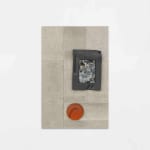Klára Hosnedlová
Untitled (wall object #1), 2020
cotton thread, terrazzo frame, terrazzo panelling, mold melted glass
200 x 132 x 15 cm
78 11/16 x 51 15/16 x 5 14/16 in
embroidery dimensions
44 x 30.5 cm
17 3/8 x 12 in
unique
78 11/16 x 51 15/16 x 5 14/16 in
embroidery dimensions
44 x 30.5 cm
17 3/8 x 12 in
unique
Further images
Across her oeuvre, Hosnedlová melds sci-fi aesthetics with the meticulously handcrafted. She began to experiment with traditional techniques of silk cotton embroidery while at art school in the class of...
Across her oeuvre, Hosnedlová melds sci-fi aesthetics with the meticulously handcrafted. She began to experiment with traditional techniques of silk cotton embroidery while at art school in the class of Czech artist Jiří Kovanda. The repetitive, painstaking handwork of creating an image from layers of thread fascinated her. To this day, she sews each embroidery herself in its entirety.
The artist develops her imagery using a protocol that defines her practice: she creates non-public performances within her exhibitions, orchestrates peculiar actions which are photographed for the exclusive purpose of providing pictorial fodder for the embroideries that will be shown in her next exhibition—where, in turn, she will design the actions, settings, and costumes for her subsequent set of embroideries. Thus, each presentation of Hosnedlová’s work over the last years has carried within it the imagery of the performance that preceded it, while each exhibition or presentation also becomes the anticipatory site and backdrop for imagery that she will realize for subsequent exhibitions. Science fiction necessitates some kind of time travel, which the embroidered scenes not only take as inspiration but also enact in their own way.
'Untitled (wall object #1),' 2020 was originally produced in parallel with the series 'Nest,' the artists’s first solo exhibition with the Kraupa- Tuskany Zeidler in 2020, curated by Sarah Johanna Theurer. 'Nest’s' formal inspiration came from Hosnedlová’s extensive research on the historical site of Ještěd Tower in the Czech Republic, a high-tech, hyperboloid example of Eastern Bloc modernism conceived by architect Karel Hubáček on a mountain peak in the mid-1960s to host a hotel, restaurant, and a TV antenna.
This sculpture reflects some of the aesthetic and formal motifs of the Ještěd Tower, particularly the sculptural use of glass. During the time of the construction of the tower, objects made from glass did not qualify as free but applied art. Therefore, it did not fall under the strict ideological control system that Stalinism applied to the cultural sector. 'Untitled (wall object #1),' references the eight glass emblems– said to embody fallen meteorites– mounted to the concrete transmitter shaft of the tower.
The artist develops her imagery using a protocol that defines her practice: she creates non-public performances within her exhibitions, orchestrates peculiar actions which are photographed for the exclusive purpose of providing pictorial fodder for the embroideries that will be shown in her next exhibition—where, in turn, she will design the actions, settings, and costumes for her subsequent set of embroideries. Thus, each presentation of Hosnedlová’s work over the last years has carried within it the imagery of the performance that preceded it, while each exhibition or presentation also becomes the anticipatory site and backdrop for imagery that she will realize for subsequent exhibitions. Science fiction necessitates some kind of time travel, which the embroidered scenes not only take as inspiration but also enact in their own way.
'Untitled (wall object #1),' 2020 was originally produced in parallel with the series 'Nest,' the artists’s first solo exhibition with the Kraupa- Tuskany Zeidler in 2020, curated by Sarah Johanna Theurer. 'Nest’s' formal inspiration came from Hosnedlová’s extensive research on the historical site of Ještěd Tower in the Czech Republic, a high-tech, hyperboloid example of Eastern Bloc modernism conceived by architect Karel Hubáček on a mountain peak in the mid-1960s to host a hotel, restaurant, and a TV antenna.
This sculpture reflects some of the aesthetic and formal motifs of the Ještěd Tower, particularly the sculptural use of glass. During the time of the construction of the tower, objects made from glass did not qualify as free but applied art. Therefore, it did not fall under the strict ideological control system that Stalinism applied to the cultural sector. 'Untitled (wall object #1),' references the eight glass emblems– said to embody fallen meteorites– mounted to the concrete transmitter shaft of the tower.






